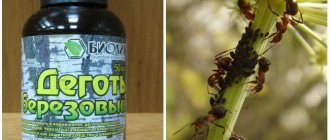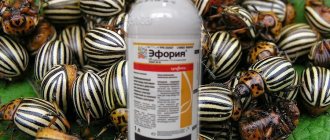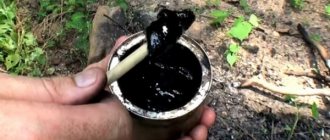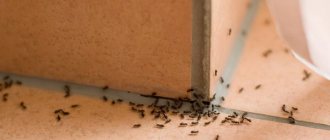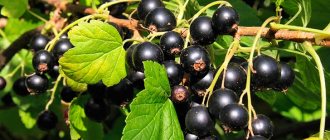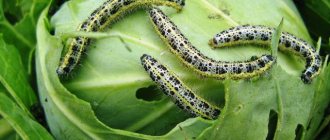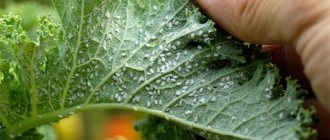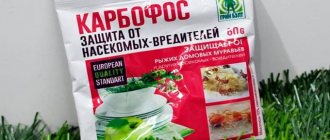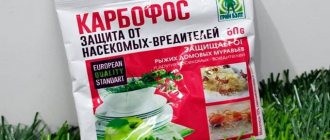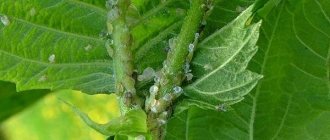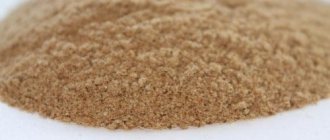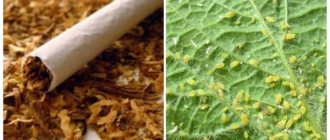Mustard is a great helper not only in the kitchen, but also in the garden. This plant not only enriches the soil, improving its structure, but is also used to protect various crops from harmful insects. One of these is aphids - the most common pest of gardens and vegetable gardens. This article will tell you how mustard is used against aphids and how effective it is.
It is no secret that one of the main reasons for the appearance of aphids on a plant is ants. They literally carry these tiny fleas on themselves, selecting new “uneaten” territories for them. The thing is that ants are attracted to honeydew - the liquid that aphids secrete during their life. This causes the leaves to become slightly shiny and sticky to the touch.
Mustard in the fight against aphids Therefore, in order to get rid of aphids, you must first of all expel the ants. You will find answers to questions about how much mustard you need, or how to prepare mustard to protect your beds and trees from pests in the recipes below.
Infusion
Mustard infusion is another simple and affordable folk remedy that helps well in the fight against harmful insects. You need to prepare it as follows: you need to dilute 100 g of mustard powder in 10 liters of water. The solution must be left for at least 24 hours, after which add the same amount of liquid and 1/3 of a bar of crushed laundry soap.
On a note!
Mustard mixture should be sprayed on trees infected with aphids. Typically, treatment is carried out 14 days after flowering.
When to use
If you use dry mustard powder to control aphids, then weather conditions do not matter. But when using aqueous solutions, it is worth taking into account climatic conditions. You should not use them if there is rain or other water precipitation outside, which includes fog and heavy dew. It is best to carry out treatment with mustard solutions when the weather is dry and windless. Then the resulting effect can last up to 8 days. After a week, the procedure must be repeated.
It may also be useful for you to learn about how to use laundry soap against aphids on currants.
Mustard is a unique plant that is in great demand in many industries: cooking, beauty and gardening. The spice is especially popular among gardeners and summer residents. Thanks to it, it is possible to solve several problems at once: saturate the soil with useful components, get rid of pests and improve the growth and development of crops. Correct and regular use of mustard solutions is guaranteed to produce a high-quality and high yield.
Solutions
You can also rid the beds of aphids with a solution. Vinegar and mustard powder (1 tablespoon of each ingredient) are added to warm water (10 l). The solution is thoroughly mixed and used to irrigate green spaces.
On a note!
When using dry powder, weather conditions do not matter. Using solutions or infusions in rainy weather will not give the desired results.
A solution of mustard with the addition of salt (preferably iodized) has an equally effective effect. It is very simple to make: 100 g of each product (salt and mustard powder) is added to 10 liters of water, stirred and used to spray damaged crops.
Using mustard
Properties of mustard
Every gardener should know that mustard can be grown as green manure. This crop saturates the soil with useful nitrogen. Thanks to this, any plant begins to actively grow and gain green mass. This is especially true for plants that serve as food for animals.
Mustard is an unpretentious crop, both in relation to soil and weather conditions. It is able to grow even at low temperatures. You can refuse to fertilize and loosen the soil. It saturates the soil with useful vitamins and microelements. And due to its spreading leaves, the growth of weeds is inhibited. The green mass is also an excellent food for pets.
Mustard will be an excellent predecessor. The soil where it grows is saturated with mustard oil. Thanks to it, the activity of wireworm, which is an enemy for tomatoes and potatoes, is reduced.
It will also be useful to learn about how to treat currants against aphids after flowering.
The plant also binds iron, which is concentrated in the ground. Thus, the possibility of developing late blight in crops that will be planted in the garden after mustard is reduced.
In the video - mustard against aphids:
The seeds of this spice are very rich in fatty oils and esters. There are also:
- proteins;
- fats;
- carbohydrates;
- organic acids;
- checkered;
- glucose;
- starch;
- vitamins A, P and E;
- carotene.
In addition, mustard contains the following elements:
- calcium;
- magnesium;
- sodium;
- potassium;
- phosphorus;
- chlorine;
- sulfur;
- iron;
- zinc;
- copper;
- manganese;
- molybdenum;
- cobalt.
Maybe
Disembarkation
Aphids, using plant sap as food, weaken them. To protect plantings from pests, you need to attract their biological enemies to your plot - ladybugs, lacewings. This can be achieved by planting mustard, tansy, dill, clover and other plants. In addition, planting mustard is an excellent fertilizer for the soil: it not only prevents the leaching of minerals, but also helps enrich it with sulfur, phosphorus and nitrogen. Mustard rids the soil of fungal infections, prevents the growth of weeds, and is a good protection against erosion.
Mustard beds are a favorable precursor for subsequent planting of crops such as potatoes or tomatoes, when growing which gardeners face many problems. The accumulation of mustard oils in the soil prevents attacks by wireworms and other insects.
Signs of infestation of trees and shrubs by aphids, danger of pests
The invasion of aphids in the garden and vegetable garden cannot be confused with anything. And if the very beginning of the appearance of pests can still be “missed” if you do not carefully inspect the plants, then soon the number of this pest grows like a snowball, and it becomes unpleasant to move around the area. When the aphid settles on the trees and begins to reproduce (and this process proceeds like an avalanche), the leaves on the plants become sticky, and its secretions turn into a fine shower that falls on the head of the unwary gardener, gluing his hair.
It is known that aphids are “herded” by ants, who feed on these sweet sticky secretions. Therefore, if ants are found on trees or bushes, you should immediately inspect the young leaves. Aphids can be different: on currants or apple trees they are light green, on viburnum they are black, but they always first nest on the underside of the leaf, sucking the juices out of it. The leaves curl and soon dry out and die. Having dealt with the leaves, the aphids begin to work on young shoots; their growth and development stops. At the same time, aphid colonies, if not controlled, grow rapidly.
Young trees stop growing due to aphid infestation
Breeding and varieties
More than 90% of mustard sown areas in Russia are occupied by varieties bred by VNIIMK. The Institute is engaged in the selection and seed production of three types of this crop: Sarepta or gray mustard (varieties Zolushka, Nika, Yuno), white (Rainbow, Kolla, Ruslana) and black (Niagara).
Sarepta mustard is the most popular and most unpretentious. Potential yield is from 2.5 to 3 tons per hectare. Seed oil content is 46-49%, essential oil content is from 0.6% to 0.7%.
White mustard has a delicate, mild taste. She is highly valued in France - and in general outside Russia she is in crazy demand. Unlike Sarepta, white mustard contains 0.2% essential oil, shows a yield of up to 2.5 t/ha, and has an oil content of 28-30%. Due to its rapid growth rate, white mustard is most often used as a green manure crop.
Black mustard is the “spiciest”. The content of essential oils in it reaches 0.9-1.0% - and, apparently, that is why pests spare it. Black mustard oil is not used for food due to its high content of erucic acid (up to 40%).
Methods for controlling aphids
To successfully control the pest, use:
- mechanical methods;
- folk remedies;
- chemical compositions.
Each method is effective, but differs in the way it influences the insect. When choosing a method, you should choose the one that will have the least negative impact on the plant. At home, it is better to use safer methods.
Mechanical removal of aphids
A simple and harmless way to remove aphids. This method is especially advisable to use when the pest has just been discovered. To do this, you just need to put on working gardening gloves and crush the aphids with your fingers. There is nothing disgusting or complicated about this process. Simple actions radically solve the problem.
Aphids can be easily washed off with a hose. It is much more powerful than aphids, so the insect is simply washed off the flowers when watering. However, watering must be done carefully so as not to damage the bush.
Complete success will be possible if rinsing occurs for several days in a row. This makes it possible to wash away new insects that are born from eggs.
Washed aphids are eaten by garden insects:
- wasps;
- spiders;
- ladybugs.
Successful mechanical removal of the pest is possible if you inspect the roses regularly.
How to treat roses against aphids using folk remedies?
It is not enough to simply poison the plant louse, as people call aphids. You need to get rid of ants. Only this will help you successfully grow beautiful flowers.
Uses of Coca-Cola
Soda has a powerful effect. It even easily removes rust, so killing aphids with Coca-Cola is doomed to success.
Coca-Cola should be prepared in this way:
- add 3 tbsp to the bottle of drink. spoons of detergent;
- mix everything thoroughly;
- after the foam has settled, the liquid is poured into a container with a spray bottle;
- The solution is sprayed so that the rose leaves become wet.
Advice! Coca-Cola can be replaced with simpler lemonade.
Use of kerosene
Kerosene will help remove aphids:
- on a bucket of water;
- ml (3 cubes if using a syringe) of kerosene;
- grated laundry soap should be added.
You need to get a slightly sticky solution. The bush is treated with the resulting composition before flowering begins. After a day, abundant watering is required to wash away traces of the composition.
Important! Kerosene is not liked by ants, which contribute to the breeding of aphids.
Ammonia
Ammonia works great against pests:
- dissolve 6 tbsp. l ammonia;
- in 1 liter of water.
Spraying is carried out weekly until the aphids are completely destroyed.
Celandine
The use of celandine provides excellent results. The herbal infusion is prepared as follows:
- 400 g of leaves, you can take dry or fresh;
- pour 1 liter of water;
- the mass is infused for a day;
- then boil for half an hour;
- the cooled product is filtered.
The leaves on the rose are sprayed with the infusion.
A nicotinic acid
Nicotinic acid helps well against caterpillars and aphids :
- half a bucket of water;
- 2 tablets of the product.
The resulting solution is sprayed. Pests are completely destroyed after just 10 days.
Using Soap
Soap solution has proven itself to be an effective method. You will need regular laundry soap:
- in 1 liter of water;
- dissolve 50 g of solid soap.
Worth noticing! Dark laundry soap is more effective. It does not contain harmful additives and will not harm roses.
Roses are treated with the solution every evening. After a couple of weeks, the aphids will completely disappear.
Using soda
A solution of soda will remove aphids and will not harm roses:
- in 1 liter of water;
- dissolve 30 g of powder.
Shoots affected by aphids are carefully dipped into the solution and left for a quarter of an hour.
Citrus zest
Remove the citrus peel and pour boiling water over it. For 1 liter of boiling water you need 300 grams of peel. The infusion should stand for 3 days in a warm, dark place. Next they spray the roses with it.
Vinegar
The use of vinegar provides a strong effect, but its solution can burn young leaves and tender buds:
- 2 tbsp. l vinegar;
- dissolve in a bucket of water.
You can spray the solution on plants or water roses from a watering can.
Tar soap
It’s a good idea to use tar soap. This product will completely repel ants and destroy pests that feed on rose juices.
The solution is made like this:
- 1 kg of ash is poured into 0.5 buckets of boiling water;
- the mixture is brought to a boil, cooled;
- 30 g of tar soap is added to the solution.
The resulting composition is sprayed onto roses.
Application of iodine
Iodine will remove aphids if mixed with milk. Prepare a solution using a syringe:
- in 1 liter of water;
- dissolve half a glass of milk;
- add 0.5 ml of iodine.
Important! The preparation with iodine protects against aphids and prevents the occurrence of fungal diseases .
Garlic
The pungent smell of garlic repels aphids. When deciding what to treat roses with , garlic is a good option.
To prepare the product take:
- 100 g peeled garlic cloves;
- pour into 3 liters of water;
- the infusion must be kept warm for at least 3 hours;
- further strain;
- increase the volume of water to 6 liters.
Serum
If attacked by aphids , the serum is used undiluted. It needs to be watered on infected plants. Sometimes a little iodine is added (20 drops per bucket of water) to increase the effectiveness of the treatment.
Copper sulfate
A combination of copper sulfate and urea will help against aphids. The resulting composition is used in early spring if the temperature reaches + 5 degrees and lasts for 3-4 days.
Required:
- 350 g urea;
- 25 g vitriol;
- all this is dissolved in 1 liter of water.
Watch the video! Aphids on roses - get rid of method No. 2
We fight the Colorado potato beetle with mustard!
To rid your potatoes and eggplants of the Colorado potato beetle, it is not at all necessary to kill it.
It is quite possible to simply scare away insects.
Ordinary mustard powder will help with this, the taste and smell of which the voracious pest absolutely cannot stand.
- general information
- Release form
- Chemical composition
- Mechanism and duration of action
- Compatibility with other drugs
- When to use?
- How to prepare the solution?
- Mode of application
- Toxicity
general information
Almost universal folk remedy. It works effectively not only against Colorado potato beetles, but also against many other pests.
These include all varieties of codling moths, wireworms, copperheads, aphids, slugs, herbivorous mites, cabbage and carrot flies.
At the same time, mustard is absolutely harmless to the environment and most of its inhabitants.
Chemical composition
Mustard seeds ground to the consistency of dust. They contain flavonoids and essential oil, which has a strong characteristic odor.
Mechanism and duration of action
How to poison the Colorado potato beetle using mustard? You need to know that mustard in no way kills pests. Its action is based on an unpleasant odor for insects, which acts as a repellent.
In addition, gnawing Colorado potato beetles and their larvae do not like leaves treated with bitter and spicy mustard.
They try to find more delicious food that smells of familiar and favorite aromas.
How to get rid of a pest? If you sow mustard between rows of potatoes, the plants will be able to repel wireworms and Colorado potato beetle larvae, while creating excellent living conditions for earthworms.
Under favorable weather conditions, mustard can work actively for quite a long time. The service life is guaranteed to be up to 4 days.
Compatibility with other drugs
Mustard powder can be combined with almost any chemical, biological and folk remedies.
It is not advisable to use mustard with preparations that attract plant pests with their smell.
Mustard powder and solution should not be used before or during rain or hail, in conditions of high humidity in the form of fog, heavy dew, or after heavy rain.
There should also be no wind, especially strong. The activity of the sun does not matter.
It is recommended to use mustard in the morning or afternoon while the larvae and beetles are actively feeding.
How to prepare the solution?
Several solution options are possible (observe the proportions!):
- The recipe is simple: pour 2-3 full tablespoons of powder with cool water (1-2 liters) and leave it alone for 2 days to get an infusion. Then the mixture is poured into a bucket with 8 liters of water, stirred thoroughly until a homogeneous solution is obtained.
- To speed up cooking, mustard powder can be brewed in boiling water. Then the solution can be used within a day.
- Preparation of the suspension requires double the amount of mustard (5-6 tablespoons). How many grams is this: approximately 100-120 g.
Before using any of the prepared options, it is filtered using a bandage or gauze folded several times. Use immediately.
To increase efficiency, you can add the following to the mustard solution:
- about 50 g of laundry soap. It must be completely dissolved in water. Add immediately before use;
- vinegar 9% concentration - 100-150 ml. It enhances repellent abilities.
Mode of application
The fight against the Colorado potato beetle includes 3 methods of using mustard powder:
- Spraying potatoes. The above-ground parts of the affected plants are sprayed with the strained solution, very thoroughly and evenly wetting all accessible surfaces. The solution should not flow down to the ground. Lipophilicity can be increased by adding liquid soap (20-30 ml).
- Soil spillage. A more concentrated suspension is applied to the soil under the bushes and between the rows. In this way, several birds are killed at once - they get rid of beetles and larvae, expel wireworms and possible naked slugs.
- Processing potatoes (dusting) with dry powder. Not only the plant bushes are treated, but also the soil around them.
Toxicity
A completely harmless product that does not harm people, animals, insects and birds.
Dry mustard does not accumulate in plants and soil.
Absolutely safe for beneficial insects and the environment.
See inaccuracies, incomplete or incorrect information? Do you know how to make an article better?
Would you like to suggest photos on the topic for publication?
general information
Aphids are a small but dangerous pest of garden crops. The size is only a few millimeters. Phytophage. It has a proboscis that pierces the surface of the stems and leaves, allowing access to the plant juices. There are winged and wingless representatives. Some species lay eggs, while others are viviparous. They secrete a lot of sweet solution - honeydew, which attracts other pests - insects and vertebrates. Life cycle:
- spring: the appearance of a larva from the egg, which feeds on plant sap →
- her molt →
- summer: parthenogenetic reproduction resulting in wingless females →
- after lignification of the stems, winged females are born (for migration) →
- autumn: birth of winged males.
The color is different and depends on the type of insect, age and habitat:
- black aphids are the most noticeable and easy to detect;
- white - almost transparent, with a slight milky tint;
- green aphids are the most problematic, as they successfully disguise themselves as greenery.
If a rose is covered in aphids, it needs to be rescued urgently, because insects feed on their sap. They spread viruses between them. They form galls - pathological growths on the leaves (less often on other parts), inside which certain insect development cycles take place.
Causes of the pest
Aphids spread very quickly and primarily attack those bushes that meet their requirements. The most attractive to this pest are juicy “fattening” shoots overfed with fertilizers. Timely, appropriate and strictly dosed fertilizing increases plant resistance to diseases and pests, while excessive overfeeding (primarily with nitrogenous substances) contributes to the appearance of aphids on roses.
With excessive nitrogen consumption, rose bushes weaken, since for normal development they also require other fertilizing, in particular potassium and phosphorus. Therefore, to provide the crop with all the necessary elements, complex fertilizers should be used, observing the characteristics of its growing season.
Another reason for a pest attack may be improper watering. Roses need sufficient moisture, but aphids prefer drought. Therefore, you need to regularly water the plantings and mulch the soil to retain moisture.
Tobacco dust
If aphids attack your plants during the flowering season, use tobacco dust. You can use both a decoction and an infusion to fight.
In the first case, tobacco dust is diluted with clean water in a ratio of 1 to 10 and boiled over low heat for about half an hour. Then the composition is filtered and infused for 24 hours. Immediately before use, add pure water 1 to 3 and laundry soap at the rate of 40 g of soap per 10 liters of working solution.
In the second case, tobacco dust is poured with warm water and left for several days before processing, after which the composition is filtered.
A pulverizer is used for processing.
Why are aphids dangerous on currants?
If strange red swellings have formed on the leaf, under which colonies of small creatures are hidden, then we can talk about the appearance of a most dangerous pest on the site - the gall aphid. The voracious creatures settle en masse on young growth, absorbing vital juices, significantly reducing the chances of getting normal harvests in the next season. The damage caused by aphids to currants is so significant that they are one of the most dangerous enemies of this crop.
How dangerous are aphids:
- By feeding on currant juices, the insect depletes the shoot, which gradually leads to drying out.
- On affected bushes, the foliage curls and becomes deformed.
- Even surviving young shoots become distorted and are severely stunted in growth.
- The sweet secretions of aphids instantly attract ants and other creatures that can further deteriorate the condition of the plantings.
- Aphids carry pathogens of infectious diseases.
- Due to the influence of aphids, productivity decreases.
Garlic tincture
Garlic is used against kidney and spider mites, aphids, whiteflies and some herbivorous caterpillars.
The infusion is prepared from 0.4 kg of chopped garlic and a bucket of water. After thorough stirring, cover the container and put it in a dark corner. After 5-6 hours, 1 liter of infusion is added to a bucket of water and the bushes are sprayed.
Another way to make an infusion to protect blackcurrants from pests: chop 200 g of the spicy vegetable and dilute with boiling water (4 l). Leave for 1 week. Add a quarter of a glass of this infusion to a bucket.
Ways to use mustard in the garden
White mustard is of particular value to gardeners as a fertilizer and pest control agent. Its well-developed root system brings nutrients from the depths of the soil to the surface. With the onset of autumn, the mustard is mowed and left to rot right on the site or placed in a compost pit. Then all the accumulated nutrients are converted into a nutrient mixture.
Mustard accumulates nitrogen and phosphorus, which are necessary for the development of fruit crops. They are converted into a form that is easy for plants to assimilate and pass on to them. The plant contains essential oils and phytoncides that disinfect the soil when digging. Plant residues, when decomposed, provide food for soil microorganisms.
Summer without ants: a simple method without chemicals! Ants, which have been known since childhood as “forest orderlies,” in a summer cottage can cause a shortage of crops….
Growing mustard on the plot is useful for organizing proper crop rotation. This plant is sown in the fall after the harvest of tomatoes and cucumbers. The mustard plant destroys dangerous bacteria accumulated during the cultivation of tomatoes. Then in the spring you can plant tomatoes or cucumbers in the same area again.
Using mustard to kill snails and slugs
These pests are very difficult to drive out of the garden. They are nocturnal and like to settle in damp places where plants are planted densely. Most often strawberries and wild strawberries suffer from slugs and snails. Pests eat their berries.
To kill slugs, mustard is used in dry form. The powder is scattered on the plants and sprinkled on the ground. Insects cannot tolerate contact with the burning substance and die or leave. You can prepare an aqueous solution from mustard powder by mixing 150 g of mustard in a bucket of water. Plants are sprayed with this composition from above.
Natural enemies
In nature, the enemies of aphids are some insects for which they serve as food. Among them are the following:
- ladybug is the main consumer, capable of destroying up to 50 aphids per day;
- sand wasp, cricket, cicada, ground beetle, tick (mite), ichneumon beetle, spiders.
Of the birds, tits and sparrows eat aphids in the largest quantities. Toads also feed on it.
To attract enemy insects, aromatic and spicy herbs are planted near the rose garden. Birds can be lured using feeders and drinkers.
Choosing the right neighbors for roses in the country
Plants that attract aphids.
Some wild trees and shrubs intensely attract pests, so it is not recommended to plant them either in the garden plot or next to it.
Plants that attract aphids:
- viburnum;
- Linden;
- bird cherry;
- mulberry;
What's bad about the company? Wild trees wake up earlier, throwing out their tender green shoots and flowers, and hungry insects flock to them from all over the area, beginning their life cycle. At the moment when your roses wake up, the pest has already created a large population and is moving into your flower garden and vegetable garden. And in this situation it is difficult to fight only with folk remedies.
In addition, there are popular flowers that also attract pests. Of course, compared to shrubs and trees, they do this on a much smaller scale.
Flowers that attract aphids:
- Petunia
- Nasturtium
- Begonia
- Cosmea
- Poppy
- Mallow
Plant allies against aphids
Let's look for helpers in our struggle among the plants. You can plant fragrant herbs and flowers in the area next to the roses that the pest does not like.
Plants that repel aphids:
- mint, lavender, sage, thyme, dill, parsley and fennel
- marigolds and daisies.
Plants that distract aphids:
- clover, lupine or rapeseed.
How to kill aphids? Beneficial insects
Unlike ants, which spread pest larvae throughout the garden, ladybugs help fight it. One such insect destroys about 700 aphids in natural conditions. We attract the ladybug to the area with tansy, dill or chamomile.
And if you have dandelions on your site, they will attract lacewings, wasps, ground beetles, and wasps that eat the pest and its larvae.
We install poultry houses for sparrows, tits, kinglets, etc. The birds feed on these larvae and also feed their chicks with them.
Agrotechnical measures
If an infestation is detected, measures must be taken before the infection spreads throughout the garden and destroys the bushes. Unfortunately, many property owners have no idea what to do in this situation. There are several ways to fight. They should be selected based on the number of insects and the stage of infection.
- Mechanical collection
Used when insects are just detected. You need to put on gloves and carefully remove the aphids from the rose, being careful not to damage the buds and leaves. Burn the collected pests outside the garden.
Some advise not to collect aphids with your hands, but to knock them down using a stream of water from a hose, aimed at the gathering of pests. However, this method does not guarantee that all parasites will be eliminated from the bushes. If you don't use the right amount of pressure, you can harm the plant.
- Trimming
After mechanical collection, carefully inspect all rose bushes. Remove curled and yellowed leaves and buds. Trim dried and dying shoots. Remove any lower branches that are in contact with the ground. If the plant is bushy, thin it out to create natural ventilation. Warmth and humidity are the best conditions for the reproduction of many pests.
- Tillage
Remove all weeds from the tree trunk. Remove old mulch, fallen leaves and branches. Carry out deep loosening. Sprinkle with mustard powder. After 2-3 days, apply root fertilizer and mulch again (peat, sawdust, pine litter, straw).
If it is too late to carry out mechanical collection, chemicals are used.
Onion peel
An infusion of onion peels is extremely effective in combating aphids. As you peel onions in winter, you don’t have to throw them away, but gradually put aside the peels.
Take 200 g of onion peel, put it in a bucket of warm water and leave for the next 15 hours. Use gauze or a sieve to strain the resulting infusion.
The resulting composition, without additional dilution, is used for spraying against aphids (with varying degrees of infestation and as a preventive measure).
Aphids can pose a serious threat to your garden. Timely measures taken will help cope with the pest in a short time and without significant losses.
© Ilya Vladimirovich | 2017-05-31 That same gardener
Mustard tincture against aphids
You can also make a tincture from mustard. This is a simple, folk method that does not require large expenses or special skills. However, it is very effective, efficient and productive. How to prepare a mustard tincture against aphids: one hundred grams of mustard powder should be mixed in ten liters of clean water. Let it brew for twenty-four hours. As time passes, pour in another ten liters of mora. And rub on the track, one third of a piece of laundry soap.
Using such a solution, the affected bush can be treated by spraying. It is recommended to carry out this activity ten to fifteen days after the plant has flowered.
